- What is Pilates?
- How does pregnancy affect the abdominal muscles, back and pelvic floor?
- Is Pilates useful in pregnancy?
- Is Pilates safe in pregnancy?
- How do I modify Pilates during pregnancy?
- Where can I do Pilates during pregnancy?
- What are some examples of Pilates exercises during pregnancy?
- Top tips for Pilates in pregnancy
What is Pilates?
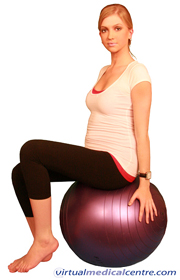
How does pregnancy affect the abdominal muscles, back and pelvic floor?
During pregnancy, the abdominal (tummy) muscles are stretched to make room for the growing baby. This may weaken the muscles, particularly the deep abdominal muscles. Deep abdominal muscles are responsible for providing support to the back (working like a corset). Lack of support makes the back vulnerable to injury. This is made worse by the hormone relaxin, which is released in pregnant women to soften the ligaments and allow the pelvis to stretch during delivery. All ligaments are softened by relaxin, including the ones in the back. With reduced support from ligaments and abdominal muscles, many pregnant women experience back pain. Relaxin remains in the body for some time after the baby is born. It is therefore important to protect the back not only during pregnancy, but also after birth, particularly when lifting, bending, breastfeeding, etc.
The pelvic floor muscles are responsible for controlling the bladder and bowel. They are weakened as they stretch and hold the weight of the growing baby. Weak pelvic floor muscles can result in difficulty controlling the bladder or bowel (incontinence) and can impact on sexual function. For example, some women find they leak urine when they cough or sneeze (stress incontinence). Around 46% of pregnant women in Australia experience urinary incontinence, and 30% have ongoing problems after delivery.
Is Pilates useful in pregnancy?
Pilates is an ideal exercise during pregnancy as it is designed to strengthen the deep abdominal and pelvic floor muscles. Strength in these areas is known as ‘core stability’. These exercises can be performed in positions that are suitable for women at all stages of pregnancy, such as on hands and knees. Such exercises may take the stress off the back and pelvic floor, and help position the baby for delivery. Pelvic floor exercises have been shown to reduce urine leakage in women with stress incontinence and women who have to rush to get to the toilet on time.
Pelvic floor exercises are an important part of Pilates, but may be carried out on their own (i.e. not as part of a Pilates program).
Is Pilates safe in pregnancy?
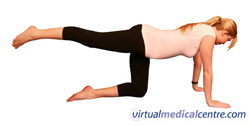
To exercise safely in pregnancy, you should be able to perform an effective pelvic floor and deep abdominal contraction. Very basic Pilates exercises are designed to achieve this. If you cannot contract your pelvic floor or deep abdominals muscles effectively, more advanced exercises may place too much strain on your joints. This is why you need to be assessed by a Pilates instructor or physiotherapist before continuing with exercises.
Certain exercises are no longer appropriate from mid pregnancy onwards due to the positions they require (e.g. lying on your tummy or flat on your back). However, exercises on hands and knees, in sitting, and in kneeling positions are all likely to be safe. As your pregnancy progresses the muscles become more stretched, and it may become more difficult to achieve good contractions.
General Pilates classes may not be suitable for pregnant women because they may involve positions that are not appropriate or may progress too quickly. Clinical Pilates (in small groups of about four people, with a physiotherapist), or studio Pilates (in small groups) are generally more appropriate. These classes tend to be based on equipment, which will provide more variety in exercises, and will still be safe. Alternatively, some ‘Pregnancy Pilates’ classes are available, and are designed specifically to suit the needs of pregnant women.
How do I modify Pilates during pregnancy?
As with all exercise, it is important to stay well hydrated. You may need to increase your intake of calories to make up for the energy and water you have lost while exercising. This may mean eating a small healthy snack (e.g. low fat yoghurt or a piece of fruit) and drinking an extra glass of water.
Pilates is a ‘low impact’ form of exercise, which means it is kind to your joints,. It can be modified so it is not too strenuous during pregnancy. However, you must monitor your energy levels. Don’t ‘overdo it’ during class, or in general. Signs that you need to slow down include:
- Being too winded to talk in a relaxed tone and rate
- Dizziness
- Uterine contractions
- Bleeding or leaking fluid
- Headache
- Nausea
- Feeling faint
- Racing heartbeat
If you experience any of these symptoms during or after a Pilates session, stop exercise, inform your instructor and, if they feel it is necessary, seek medical advice.
As you get larger during pregnancy, your centre of gravity shifts forward, affecting your balance. Be cautious with activities such as getting on and off equipment, balancing exercises, and getting up and down from the floor.
Due to the hormone relaxin, your joints are more flexible during pregnancy. It is important you do not overstretch, as this may cause injury. Working in a small range of movement, working on control and core strength is more appropriate.
As your tummy gets larger and the muscles stretch, it will become more difficult to achieve a good contraction. Continue to focus on achieving a sense of activating your abdominals and pelvic floor, and don’t compensate by ‘squeezing harder’ and activating other muscle groups.
Avoid abdominal crunches and curls
Avoid abdominal crunches and curls throughout pregnancy. Using the rectus abdominis muscle (the ‘six pack’ muscle that runs down the front of the tummy), particularly as you grow larger with pregnancy, may increase the chance abdominal diastasis, where the connecting tissue that holds the two sides of the rectus abdominis muscle together is separated. Some degree of diastasis is common during pregnancy. If abdominal diastasis is present, have it assessed by your doctor or physiotherapist. They will check the way you are using your muscles to make sure it is not worsening the diastasis. Abdominal crunches also increase strain on the lower back, and may cause injury there.
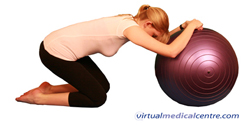 |
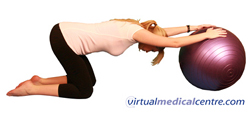 |
Don’t overdo it, particularly if you are feeling exhausted or nauseous. These sensations often improve later in pregnancy, allowing you to do more.
Focus on:
- Arm strengthening
- Pelvic floor exercises
- Squatting exercises
- Pelvis and lower back stability
- Spinal stretches (gentle)
- Postural exercises
Avoid:
- Exercises with legs wide apart (e.g. side stretches on the reformer). These may place strain on the joint at the front of your pelvis (symphysis pubis).
- Lying flat. This may reduce the blood supply to you and your baby. If this occurs, you may feel dizzy or lightheaded.
- Abdominal crunches
- Extreme stretches
- Unstable balance exercises
- Unsupported back bends
- Inversions (where your feet are higher than your heart, with your hips up too)
- Sharp percussive movements
- Jumping
Focus on:
- Gentle stretches (these should feel good!)
- Arm exercises
- Supported back bends (such as over a bolster)
- Stability exercises for your lower back and pelvis
- Pelvic floor exercises
- Breathing exercises
- Thigh strengthening exercises (though not a deep squat in the last 4-6 weeks of pregnancy, as this may induce labour)
Avoid:
- As per second trimester; also
- Deep squats during the last 4-6 weeks of pregnancy (increases pressure on the cervix and may induce labour)
- Exercises on one leg or with legs apart (lunges, splits)
Where can I do Pilates during pregnancy?
Check with your doctor or midwife before commencing Pilates.
Pilates in Pregnancy classes are available, and are ideally suited to the needs of pregnant women. If you have not done Pilates before, you need to go to a Pilates in Pregnancy class, studio Pilates session, or clinical Pilates with a physiotherapist, where you can receive individual attention. This is also the best environment if you have done Pilates in the past.
There are Pregnancy Pilates books, videos and DVDs available, but you should not start Pilates on your own with these resources if you have not received feedback from an instructor to ensure that you are performing the basics correctly.
What are some examples of Pilates exercises during pregnancy?
These exercises can cause harm if performed incorrectly. You should be supervised by a physiotherapist, Pilates instructor or midwife to make sure you are doing them properly before carrying them out on your own, particularly during pregnancy.
These exercises can be performed in any position. To start, perform these exercises in a sitting position, or on hands and knees.
The pelvic floor muscles are those around the vagina and back passage. To contract them, you should draw the muscles ‘up and in’. To practice, imagine the muscles you would tighten to prevent passing wind from your back passage, or to stop the flow of urine. Do not practice these exercises by stopping urine flow when you are on the toilet. Practice tightening these muscles around the back passage, then try the same contracting movement further forward around the vagina. You should not be tightening your buttock or leg muscles. The most serious mistake people make when carrying out these exercises is to ‘bear down’ or push down rather than ‘lifting up’. This ‘straining’ actually stretches the pelvic floor and makes it weaker.
Some programs suggest a series of ‘quick flicks’ of 2 second pelvic floor contractions, followed by sustained 5 second contractions, aiming to build up to 10 second contractions.
Relax your pelvic floor completely for 10 seconds between each contraction. Do not hold your breath during contractions. It is important to concentrate and focus on each separate contraction.
Basic deep abdominal contraction
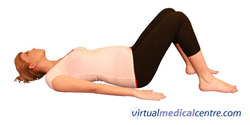
Breathe in. On the breath out, contract your pelvic floor, and gently draw your belly button down towards your spine (crook lying) or lift your belly button up towards your spine (4 point kneeling). Do not ‘suck in your stomach’. The contraction should be gentle (about 30% of maximum effort).
Try to maintain this pelvic floor and abdominal contraction for 10 seconds. Do not hold your breath or move your back during this time. Gently relax after 10 seconds. Repeat this exercise 10 times.
Top tips for Pilates in pregnancy
- Before starting Pilates classes, consult your doctor.
- Have an assessment of your posture by a qualified instructor before starting to make sure the program is appropriate. Have an assessment of your pelvic floor and abdominal strength by a qualified instructor to make sure you are carrying out the exercises correctly.
- Wear a properly fitted bra and comfortable, nonrestrictive clothing.
- Continue classes with an instructor so the program can be modified appropriately as your pregnancy progresses.
- Monitor your energy levels during Pilates so you don’t overdo it. Watch out for ‘warning signs’ as listed above, and consult your doctor if they occur. Don’t get overheated.
- Don’t overstretch your joints. Don’t do abdominal crunches or curls.
- Don’t lie flat or with your feet over your head in the second half of your pregnancy.
- Take care with your balance. Don’t get up from the floor too quickly.
- Keep up your fluids and eat a small healthy snack.
- Good quality deep abdominal contractions will be difficult once the muscles are stretched during the later stages of pregnancy. Focus on gentle contraction, posture, and pelvic floor work.
More information
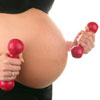 |
For more information about pregnancy and exercise, including pre-pregnancy exercise, suitable types of exercise, risks and benefits of exercise and exercise myths, see Pregnancy and Exercise. |
 |
For more information about pregnancy, including preconception advice, stages of pregnancy, investigations, complications, living with pregnancy and birth, see Pregnancy. |
 |
For more information on fitness and exercise, including stretches, types of exercise, exercise recovery and exercise with health conditions, as well as some useful videos, see Fitness |
References
- Balogh A. Pilates and pregnancy [Review]. RCM Midwives. 2005; 8(5): 220-2.
- Conditioning by Pilates. Harvard Women’s Health Watch. 1999; 6(5): 7.
- Robinson L. Pilates in pregnancy: The Body Control method. Practicing Midwife. 2007; 10(3): 24-6.
- Chiarelli P, Bower W, Wilson A, Attia J, Sibbritt D. Estimating the prevalence of urinary and faecal incontinence in Australia: Systematic review. Aust J Ageing. 2005; 24(1): 19-27.
- Wesnes SL, Rortveit G, Bo K, Hunskaar S. Urinary incontinence during pregnancy. Obstet Gynecol. 2007; 109(4): 922-8.
- Hofmeyr GJ, Kulier R. Hands/knees posture in late pregnancy or labour for fetal malposition (lateral or posterior). Cochrane Review. 1998. Chichester: John Wiley & Sons, Ltd. Issue 1. Art. No.: CD001063. DOI: 10.1002/ 14651858.CD001063.
- Sampselle CM, Miller JM, Mims BL, Delancey JOL, Ashton-Miller JA, Antonakos CL. Effect of pelvic muscle exercise on transient incontinence during pregnancy and after birth. Obstet Gynecol. 1998; 91(3): 406-12.
- Bo K, Talseth T. Long-term effect of pelvic floor muscle exercise 5 years after cessation of organized training. Obstet Gyncol. 1996; 87: 261-5.
- Beck R. Getting to the core. Using pilates to promote overall wellness during rehabilitation. Rehab Management. 2008; 21(2): 34-6.
All content and media on the HealthEngine Blog is created and published online for informational purposes only. It is not intended to be a substitute for professional medical advice and should not be relied on as health or personal advice. Always seek the guidance of your doctor or other qualified health professional with any questions you may have regarding your health or a medical condition. Never disregard the advice of a medical professional, or delay in seeking it because of something you have read on this Website. If you think you may have a medical emergency, call your doctor, go to the nearest hospital emergency department, or call the emergency services immediately.







